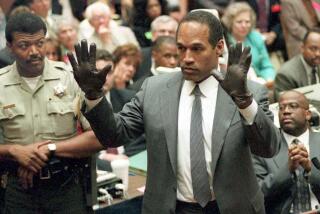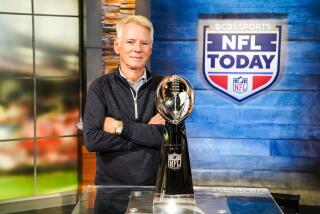TV And Radio in the Eighties : Cable Channels, VCR Lead TV Revolution for Viewer Independence
- Share via
Free at last.
Free from three guys at ABC, CBS and NBC deciding what you see on TV.
Free from having to watch shows only at their scheduled times.
Free from the shopworn, burned-out mentality of most network shows.
That’s what the 1980s really were about for TV viewers.
The new way that people started watching TV was as important as the shows themselves.
Call it the zap decade.
With a vast array of cable channels and hand-held remote controls, viewers began zapping from one station to another, challenging programmers to stop them and hold their attention.
It was a nightmare for professional programmers.
Public-access shows that cost amateurs $50 a half hour were suddenly just as easy to tune in as $400,000 network sitcoms.
But for viewers, the sudden change was heaven.
For the first time, viewers became their own programmers, selecting at random anything they wanted from the cornucopia of shows on what now were 30, 40, 50 or more channels.
David Letterman had it right. “TV is becoming like radio,” he said, referring to the multiplicity of choices that could be likened to the FM revolution.
Choice was the magic word.
Producer Fred Silverman also saw parallels with radio.
“Television is getting just as loose and informal on the new outlets,” he said.
Revolution, pure and simple.
In past decades, what you saw mostly were TV shows of that particular time.
But the explosion of new channels in the 1980s meant a need for programs to fill them. Many of the programs were movies and TV shows of the past, providing an instant sweep of U.S. social history never before available on the tube in such detail.
The established Big Three networks tried to pooh-pooh the new program choice, saying much of it was simply reruns.
True. But they missed the big picture--the new perspective of past and present not only for the older generation, but younger viewers as well.
No longer was it necessary to go to museums and art houses to catch “Citizen Kane” and “It’s a Wonderful Life” and find out what all the shouting was about. Not when they became repeatedly accessible on cable.
Sid Caesar, Ernie Kovacs and Milton Berle no longer were simply revered TV memories. Not when they popped up with frequency on the new channels.
There were also, of course, the countless silly old movies and silly--but loved--old television shows, like “Mr. Ed” and “Leave It to Beaver.”
And combined with such new TV riches as “Hill Street Blues,” “Cheers,” “L.A. Law” and “Cagney & Lacey,” there was a wealth of material all over the dial for selective viewers.
In many ways, it was the beginning of TV’s most significant Golden Age.
For the total TV experience--not merely individual shows--was becoming the quintessential trip for viewers.
No longer was network prime time the only big picture on TV.
Free at last.
And nothing freed viewers more than VCRs.
Now you could tape a show and watch it any time you wanted.
Now you could rent or buy a movie and watch it instead of TV, at your leisure.
Without commercials.
And now it was a sponsor’s nightmare as well as a programmer’s.
Free at last.
Under the assault of VCRs and cable, networks began to shrivel. Viewers defected in huge numbers.
Many went to the growing number of independent stations. Many went to the new Fox TV network, with its flashy lineup of such series as “America’s Most Wanted” and “Married . . . With Children.”
At the start of the decade, ABC, CBS and NBC shared 85% of the national TV audience. By the end of the ‘80s, they were down to 67%.
Only occasional huge programming events, like the finale of “MASH,” “The Winds of War,” a Super Bowl game--or a rare series like “The Cosby Show”--could temporarily win back network viewers in major fashion.
The figures were devastating. Take cable. In 1980, only 22% of TV homes had it. Now the total is 57%.
That’s more than 52 million homes--and rising. There are 92 million TV homes in America.
But no figures are more devastating than the ones for VCRs. Almost invisible at the start of the decade, VCRs now are in 66% of American homes.
And while VCR viewing has had an enormous effect on the film business, its damage has been mostly to TV, says media analyst Tom Adams of Kagan Associates in Carmel.
“Cassette-renting is an activity more like watching TV than going to a movie,” he says. “So it replaces TV time. It doesn’t replace the movie experience.”
The network viewing experience, meanwhile, was getting whacked on another critical front. Kids, a bulwark of profits for the Big Three, were especially being lured away.
A new generation of youngsters was growing up not caring about ABC, CBS or NBC any more than it did MTV, HBO or VH-1. Channels 2, 4 and 7 no longer seemed terribly different from Channels 42, 44 or 47.
And kids took to VCR home viewing of films in a tremendous way.
“The movie experience thrives on the teen-age audience, which grew up in the video age,” says Adams. “They could watch their favorite movies over and over again at home.”
And VCR viewing also cut sharply into the audience most desired by sponsors, young adults 18-34, another heavy movie rental group.
Everything in the ‘80s seemed to conspire against the traditional habits connected with watching network TV. News, for instance, used to be the almost exclusive domain of the Big Three. TV giants like Walter Cronkite went unchallenged for viewers.
That ended in the 1980s. Cronkite got out just in time, retiring as anchor in 1981--probably forced out earlier than he wanted in order to make room for Dan Rather, whom CBS feared might be hired by a competitor.
In retrospect, Cronkite’s retirement now seems a benchmark. For more than anyone, he symbolized the nightly network news and the habit of tuning it in.
But on June 1, 1980, a renegade entrepreneur named Ted Turner launched an upstart TV operation called Cable News Network, which enabled viewers to tune in 24 hours a day to find out what was going on.
By the end of the decade, CNN had become the nation’s network of record for TV news. And there was no need anymore to rush home in time to watch CBS’ Rather, ABC’s Peter Jennings or NBC’s Tom Brokaw with their nightly reports.
CNN reached about 2 million homes in its first year. Now it’s available in 51 million television households and more than 80 nations.
Once upon a time, networks and TV stations were such sure-fire money machines that a wiseacre said, “A license to broadcast is a license to steal.”
But the embattled networks suddenly found themselves gobbled up by buyers in the 1980s--NBC by General Electric, ABC by Capital Cities Communications and CBS by one of its stockholders, Laurence Tisch.
And while the Big Three, especially CBS, were suddenly absorbed with survival in the new killer climate of corporate mergers, the burgeoning pay and cable networks clearly saw the TV future: specialty channels aimed at specific audiences.
Thus, while ABC, CBS and NBC tried to be all things to all people, MTV changed the face of television with its music-video format, ESPN went for the sports crowd and Bravo and the Arts & Entertainment network focused on cultural programming.
CNN got better and better. The Disney Channel developed a splendid schedule that went for specific age groups at different times of the day. HBO, Showtime, the Movie Channel and Cinemax led the way in getting films for pay TV--and destroyed the value of motion pictures on the Big Three networks because growing cable audiences now could see them months or even years before.
Public-access stations let anyone do a cable show. The Lifetime network focused on women.
Suddenly, there was a Travel Channel, a Weather Channel. There was C-SPAN with two channels covering the House of Representatives and the Senate. There was a Nashville Network. A Black Entertainment Network.
Lovers of old and often brilliant films could find them on the American Movie Classics network, TNT and the Nostalgia Channel, which geared its programming to middle-age and older viewers.
Startling was the word for the TV turnabout.
“At the beginning of the decade, Hollywood was getting less than 1% of its earnings from videocassettes,” says analyst Adams. “Now the figure is about 45%.”
Viewing habits were changed once and for all. Yet even this fall the Big Three kept cranking out stupefyingly dated potboilers like “Sister Kate,” “Island Son” and “Living Dolls.”
But the only ones who got hurt by such shows were NBC, CBS and ABC. And it doesn’t matter to viewers anymore.
Click. On to cable.
Click. On to VCRs.
Free at last.
MASS MEDIA
The 10 Most-Watched TV Programs of the ‘80s
1.”MASH” (final episode), CBS, 2/28/83 50.1 million homes
2.”Super Bowl XX,” NBC, 1/26/86 41.49 million
3.”Dallas” (“Who Shot J.R.?” episode), CBS, 11/21/80 41.47 million
4.”Super Bowl XVII,” NBC, 1/30/83 40.5 million
5.”Super Bowl XXI,” CBS, 1/25/87 40.03 million
6.”Super Bowl XVI,” CBS, 1/24/82 40.02 million
7.”Super Bowl XIX,” ABC, 1/20/85 39.4 million
8.”Super Bowl XVIII,” CBS, 1/22/84 38.8 million
9.”The Day After,” ABC, 11/20/83 38.5 million
10.”Super Bowl XIV,” CBS, 1/20/80 35.3 million
SOURCE: Source: Nielsen Media Research
More to Read
The complete guide to home viewing
Get Screen Gab for everything about the TV shows and streaming movies everyone’s talking about.
You may occasionally receive promotional content from the Los Angeles Times.






